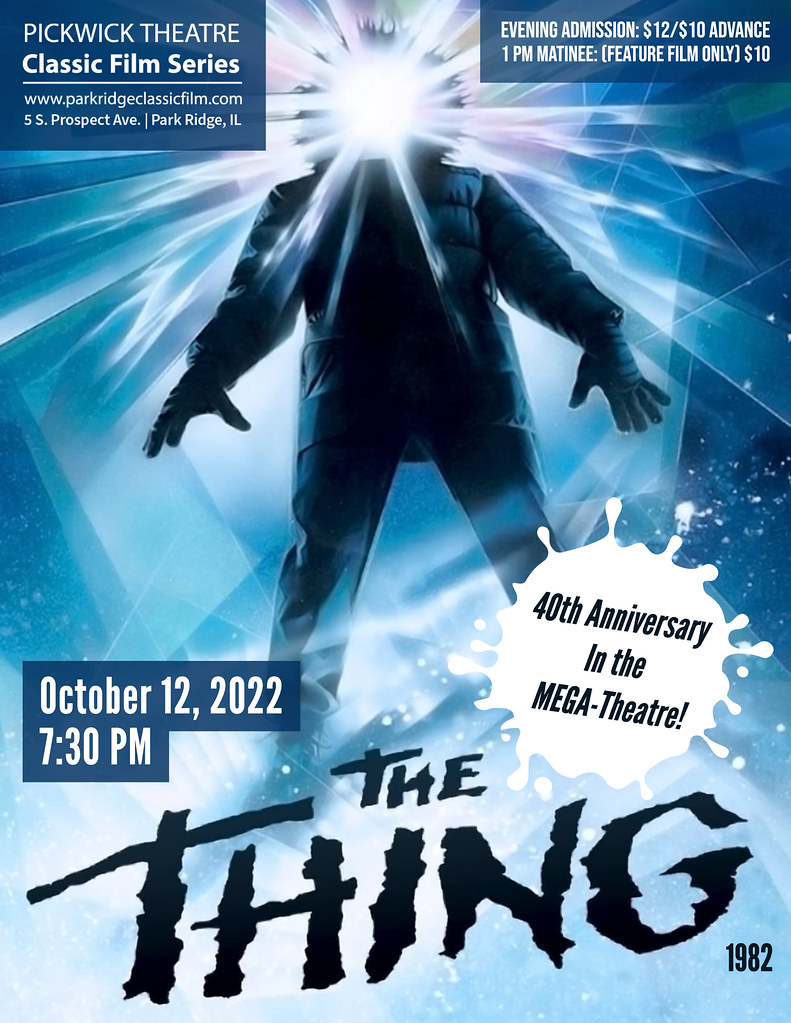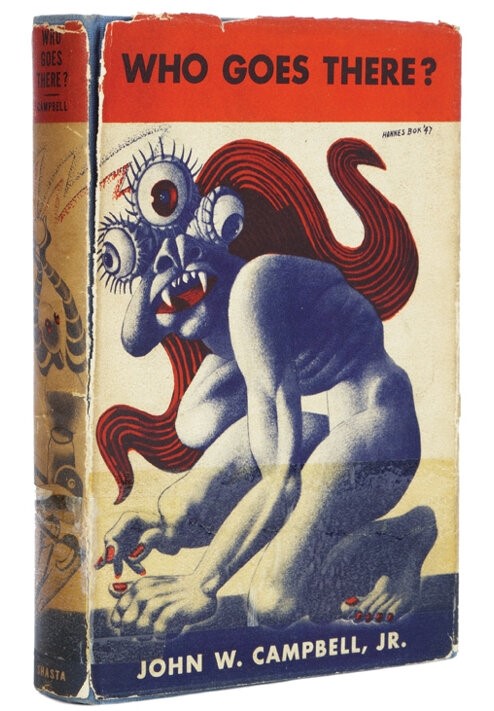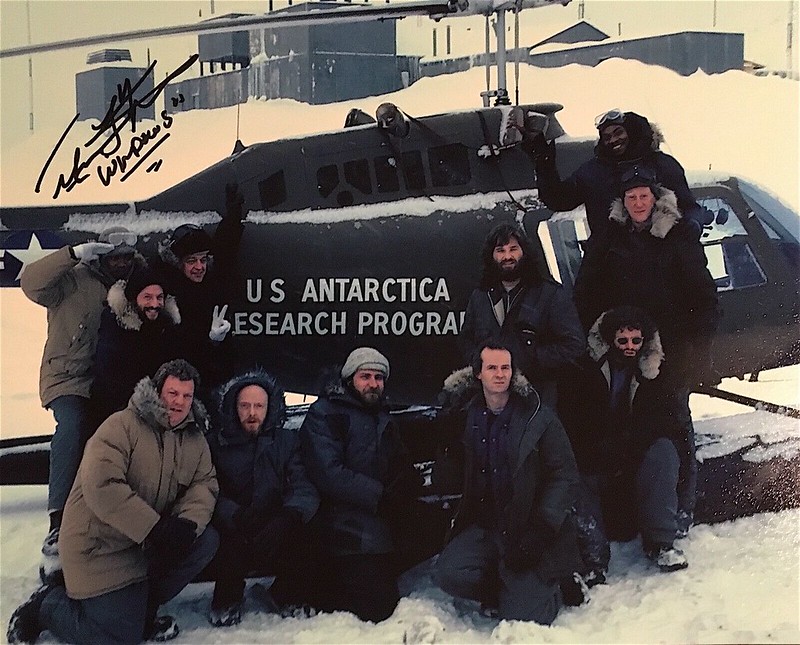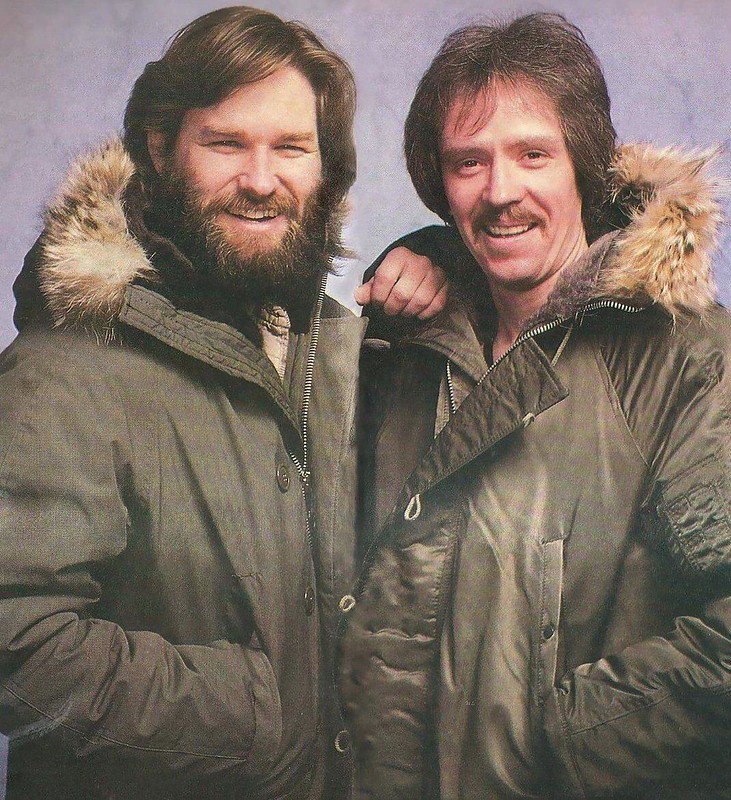WHAT: The Thing (1982, DCP) 40th Anniversary
WHEN: October 12, 2022 1 PM & 7:30 PM
WHERE: Pickwick Theatre, Park Ridge, IL
HOW MUCH: $12/$10 advance or $10 for the 1 PM matinee
Advance Tickets: Click Here!
Note: This film is Rated R.
“Carpenter and I worked on the ending of that movie together a long time. We were both bringing the audience right back to square one. At the end of the day, that was the position these people were in. They just didn’t know anything… They didn’t know if they knew who they were… I love that, over the years, that movie has gotten its due because people were able to get past the horrificness of the monster… to see what the movie was about, which was paranoia.” ~Kurt Russell
For my generation, the early 1980s were a wonderful time to be a kid at the movies. The year 1982, in particular, saw the release of several noteworthy films which I saw in a theatre, including Poltergeist, Blade Runner and E.T. The Extraterrestrial— the latter being the “optimistic” alien invasion movie of the year. But there was another alien movie that year– less cuddly, less sentimental, less feel-good. In fact, it was downright nihilistic. Unlike E.T., which I’ve seen maybe once since my childhood, I’ve come to view John Carpenter’s The Thing as the far more interesting film.
The appreciation for The Thing was a long time coming, both for general audiences as well as for myself. In truth, I never saw the film in 1982. The fact that it was “R” wouldn’t have dissuaded my dad from taking me as I do recall seeing John Carpenter’s Escape From New York (1981) in a theatre. At that time, though, I may have simply been biased against a “remake” of a classic film, that being the Howard Hawks-produced The Thing From Another World (1951).
In the years since its release, viewers have come to recognize that the movie is less a remake than a “re-fashioning.” The Thing stands on its own and has been recognized as one of the great science fiction/horror films of the era. Forty years after its release, The Thing is the epitome of claustrophobic terror.
The idea of a remake began in the mid-1970s and took on steam when director Ridley Scott released the first Alien movie in 1979. In those early years of story development, several directors and writers were attached to the project. However, with the success of movies like Halloween (1978), John Carpenter emerged as the ideal candidate for The Thing given his experience in the genre. Instead of simply remaking the Howard Hawks version– a film Carpenter greatly admired– he returned to the source material.
The Thing was based on the 1938 novella, Who Goes There?, by John W. Campbell, Jr., which originally appeared in Astounding Stories. The story follows a group of research scientists in Antarctica who discover the frozen remains of some thing. The alien is not dead, however. In the 1951 film, the alien is basically a homicidal vegetable. By contrast, the Carpenter film would restore the shape-shifting ability of the creature– a being which can take over the bodies of humans and animals alike. In the screenplay by Bill Lancaster (son of Burt), the camaraderie from the original film is replaced with paranoia and mistrust. Each of the twelve men suspects the others of being infected.
The cast is headed by Kurt Russell, who had worked with John Carpenter previously in the 1979 TV movie Elvis, as well as Escape From New York, in which he played the iconic, eyepatch-wearing Snake Plissken. In The Thing, Russell is MacReady, a loner helicopter pilot who is forced into the leadership role as the story unfolds. His character is very much a realist. Russell is supported by an ensemble cast that includes: A. Wilford Brimley (Blair), T.K. Carter (Nauls), David Clennon (Palmer), Keith David (Childs), Richard Dysart (Dr. Copper), Charles Hallahan (Norris), Peter Maloney (Bennings), Richard Masur (Clark), Donald Moffat (Garry), Joel Polis (Fuchs), and Thomas G. Waites (Windows). The film is unique in that there are no female characters in the film at all, although as a bit of trivia, the voice of MacReady’s chess computer is performed by Adrienne Barbeau, who was Carpenter’s wife at the time.
According to Carpenter, second unit filming began on June 1, 1981, near Juneau, Alaska. These scenes included the exterior shots of the helicopter pursuing the wolf-dog. Principle photography began on August 24. The set depicting the research outpost was shot in Stewart, British Columbia; it was a remote location that could only be reached by bus. The daily shoot became an arduous trek for cast and crew. The filming, which lasted about 12 weeks, proceeded under generally difficult conditions. However, unlike previous films, this was John Carpenter’s first for a major studio and he had the luxury of a larger budget ($15 million).
Particularly effective was the production design by John J. Lloyd, which helped create a feeling of claustrophobia within the narrow corridors of the snowbound base. Interiors were mostly recreated back at the Universal lot with sets being refrigerated. In addition, the atmospheric cinematography and lighting by Dean Cundey, who had shot Carpenter’s earlier films, added tremendously to the film’s overall look. One scene in particular, which reveals some of the best work from both Lloyd and Cundey, is the sequence in which MacReady and Dr. Copper visit the abandoned Norwegian camp.
But it would be the special effects that audiences would remember most. For John Carpenter, he did not want to make a monster movie with a man in a suit, which was how the original had been filmed with James Arness. Instead, the film would rely heavily on its special effects; $1.5 million of the film’s budget was reportedly spent on creature effects. Rob Bottin, who had worked on Carpenter’s The Fog, was tasked with creating unimaginable horror with a surreal, abstract quality.
The creature wasn’t just one thing but several things– perhaps all the things it had come into contact with throughout its travels across the galaxy. Using both puppetry and animatronics (and a lot of food products!), Rob Bottin designed some of the most nightmarish and creepy effects ever seen. According to Bottin, there are 45 different glimpses of the creature. Carpenter described the thing as something “like a Chinese box”– one underneath the other– that keeps imitating during its life cycle.
The film’s score was performed by the illustrious Ennio Morricone. Best known for his Western scores with Sergio Leone, Morricone was a master composer who basically created music in the style of his director; John Carpenter typically scored his own films. It’s a moody score, but it’s more suggestive of Carpenter than the motifs we typically associate with Morricone. In some places in the film, Carpenter added music cues himself, which he described more as sounds rather than music.
The Thing was released to disappointing reviews– one of which referred to it as “instant junk.” Critics as well as audiences were put off by the horrific scenes and shots of blood. Although The Thing was not a failure at the box office, it wasn’t a success either. Despite the negative critical reception, the film managed to gross $19.6 million. By comparison, E.T.: The Extra-Terrestrial, which was released two weeks prior to The Thing, went on to gross $359 million. Some of the other films that year that inexplicably did better at the box office included Porky’s ($105 million), The Best Little Whorehouse in Texas ($69 million), The Toy ($47 million), and Friday the 13th Part 3 ($34 million).
MacReady (Kurt Russell)… carrying out the mission for a greater cause.
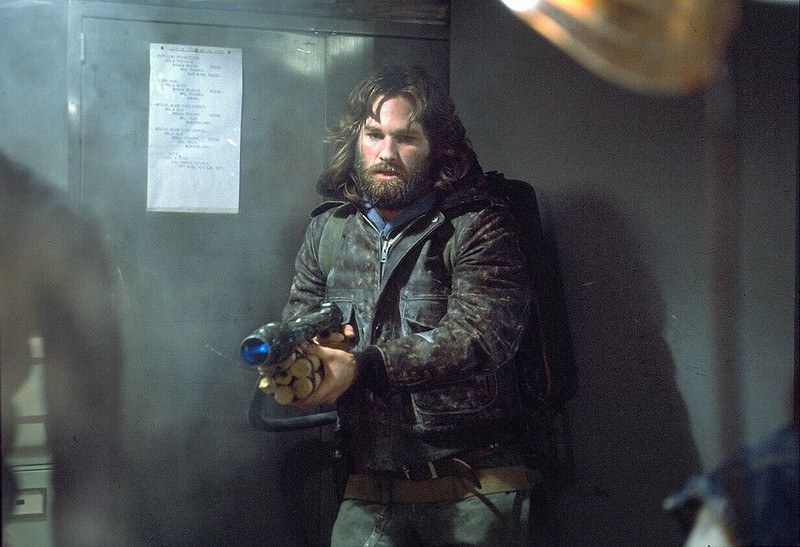
But the passage of time has been kind to The Thing. In 2020, the film is generally regarded as a classic in science fiction. Its indirect links to H.P. Lovecraft’s “cosmic horror” stories are another draw for fans of the genre. The year 1982 simply was not the right time for a film like The Thing, which was more nihilistic in its tone than anything that was playing at the time. In fact, the film is part of Carpenter’s “Apocalyptic Trilogy,” which also includes Prince of Darkness (1987) and In the Mouth of Madness (1995). The film teeters on the brink. Mankind itself is threatened with extinction. Thus, there’s a strong parallel to today’s precarious situation with disease and war. After all, it only takes one monster to send the world into nuclear Armageddon.
The film also anticipated some of the emerging paranoia associated with the AIDS epidemic. One of the film’s most famous scenes is the blood test in which MacReady tests the blood of the men to see if any are infected by the creature. At the time, the AIDS epidemic was still an unknown in society. People didn’t know where it came from or who might have it. That subtext certainly resonates in our own world in which we are recovering from a global pandemic. At the height of COVID-19, how many of us weren’t wondering if our neighbor had the virus?
John Carpenter, in his prime, knew how to end a movie. The wrap-ups to films like Halloween and Escape From New York immediately come to mind for those familiar with his work. The Thing is no exception. It’s the perfect ending with one of the great closing lines in movie history. Other endings were considered with different tones and explanations, but The Thing ends the only way it should.
~MCH
